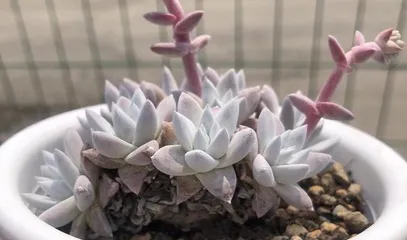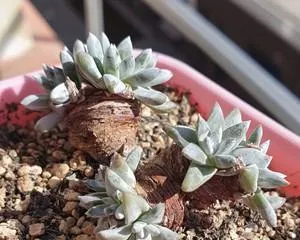White Succulent Daisy is a beautiful succulent plant with a unique shape and vibrant colors, loved by gardening enthusiasts. However, growing a healthy and beautiful White Succulent Daisy is not easy and requires mastering certain care techniques. This article will introduce you to the planting and care knowledge of White Succulent Daisy to help you create an ideal one.

Choose the Right Potting Soil
If you want to grow a healthy White Succulent Daisy, the first step is to choose the right potting soil. Succulent plants have a well-developed root system and prefer soil that is breathable and has good drainage. Therefore, the potting soil should be a formula with high sand content and sufficient organic matter. When making the potting soil, you can mix in materials like vermiculite and perlite to enhance drainage, and add an appropriate amount of matured compost to improve the soil's fertility.
Pay Attention to Suitable Light
White Succulent Daisy loves a sunny environment but should not be exposed to scorching sun. Generally, you can place the White Succulent Daisy on a balcony or by a window to ensure it can fully absorb sunlight while avoiding intense direct light. It should be noted that during high summer temperatures, it should be properly shaded to prevent the White Succulent Daisy from being damaged by excessive heat.

Maintain Suitable Temperature
White Succulent Daisy prefers a warm and dry environment, with a suitable growth temperature of around 20°C-28°C. During high summer temperatures, pay attention to ventilation and cooling to prevent the plant from overheating and causing leaves to wither. When the temperature is low in winter, pay attention to strengthening insulation measures to avoid freezing injury to the White Succulent Daisy.
Water Properly
Succulent plants do not like a humid environment, so watering should be moderate and waterlogging should be avoided. Generally, you can judge whether watering is needed based on the moisture of the potting soil surface. When the temperature is high in summer, the frequency of watering can be increased, but be careful not to overwater to cause root rot. When the temperature is low in winter, the frequency of watering should be reduced to avoid freezing of the roots.
Pay Attention to Fertilizer Application
The nutritional requirements of succulent plants are not high. Generally, applying a compound fertilizer once a month is sufficient. It should be noted that the amount of fertilizer should be appropriate, and a fertilizer suitable for the growth of succulent plants should be chosen. It is recommended to choose a compound fertilizer containing various trace elements and apply it according to the instructions on the manual.

Prune Branches and Leaves Properly
The branches and leaves of White Succulent Daisy grow rapidly and need regular pruning to maintain a good growth state. When pruning, use sharp tools to avoid secondary damage to the plant. At the same time, pay attention to leaving a certain length at the junction of the branches and leaves and the main stem to provide nutrients for the plant.
Prevent Pests and Diseases
White Succulent Daisy is relatively resistant to pests and diseases, but it is also susceptible to some of them. Common ones include aphids and powdery mildew. Once pests or diseases are found, timely measures should be taken for prevention and control to avoid excessive damage to the White Succulent Daisy.
Pay Attention to the Timing of Repotting
Succulent plants grow fast and generally need to be repotted every year. It is recommended to repot in spring to provide a more suitable growth environment for the plant. When repotting, choose fresh and fertile potting soil, and pay attention to properly pruning the roots.
Increase Nutrient Intake
White Succulent Daisy needs sufficient nutrients to maintain its growth and development, so nutrient intake can be appropriately increased. It is recommended to use a special nutrient solution for succulent plants that is rich in nutrients such as trace elements and amino acids for supplementation.
Select High-Quality Seedlings
If you want to grow an ideal White Succulent Daisy, selecting high-quality seedlings is very important. When purchasing, choose seedlings that are healthy, lush, with full leaves and bright colors, and try to avoid purchasing seedlings that are growing poorly or have been infested with pests and diseases.
Avoid Large-Scale Movement
The root system of succulent plants is not well-developed. Large-scale movement will hinder the growth and development of the plant, so large-scale movement of the White Succulent Daisy should be avoided as much as possible.
Maintain Soil Moisture
The moisture level of the potting soil for succulent plants is relatively sensitive. Both excessive dryness and excessive moisture will adversely affect the plant. Therefore, it is necessary to master the appropriate amount of watering to maintain the suitable moisture level of the potting soil.
Follow the Growth Pattern
The growth pattern of White Succulent Daisy is relatively fixed, usually growing rapidly in spring and summer, and stopping growth in autumn and winter. Therefore, different maintenance measures should be taken in different seasons to adapt to the growth pattern of White Succulent Daisy.
Drainage Should Be Timely
The root system of succulent plants is relatively well-developed and does not like waterlogging. Therefore, drainage should be timely after watering to avoid waterlogging.
White Succulent Daisy is a beautiful succulent plant, and its cultivation and care require mastering certain skills. To grow a healthy and beautiful White Succulent Daisy, it is necessary to choose suitable potting soil, light, temperature, watering, fertilizer, prune branches and leaves regularly, prevent pests and diseases, pay attention to the timing of repotting, etc. Only by mastering these skills can you successfully grow a White Succulent Daisy in good condition.